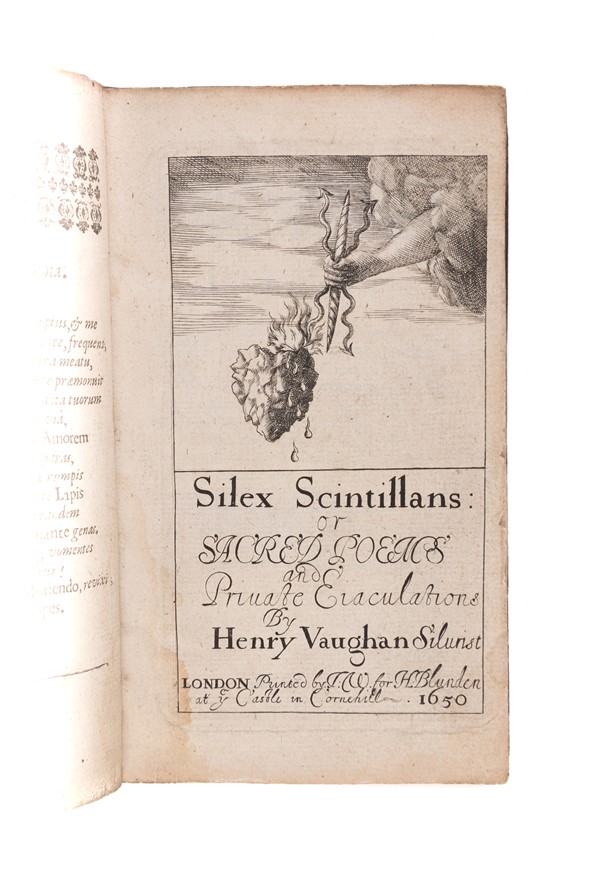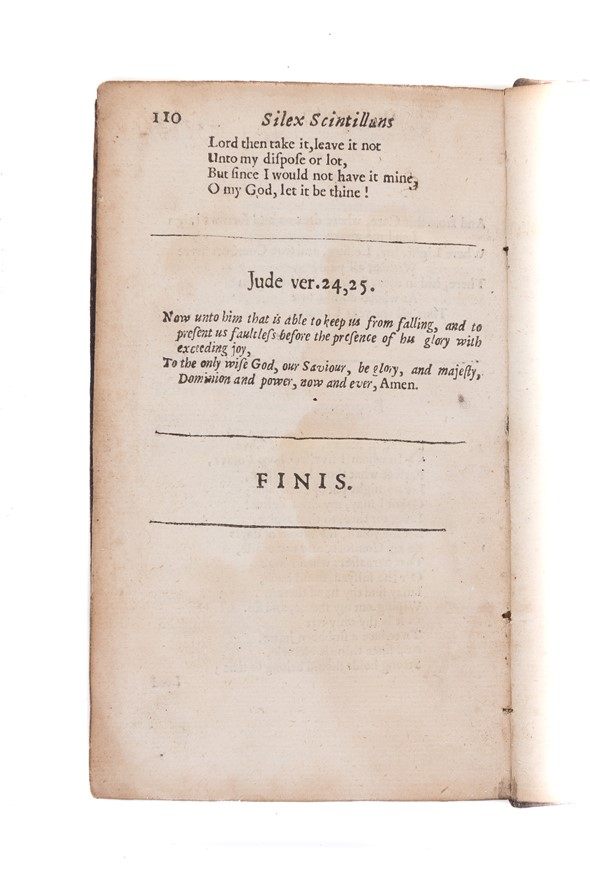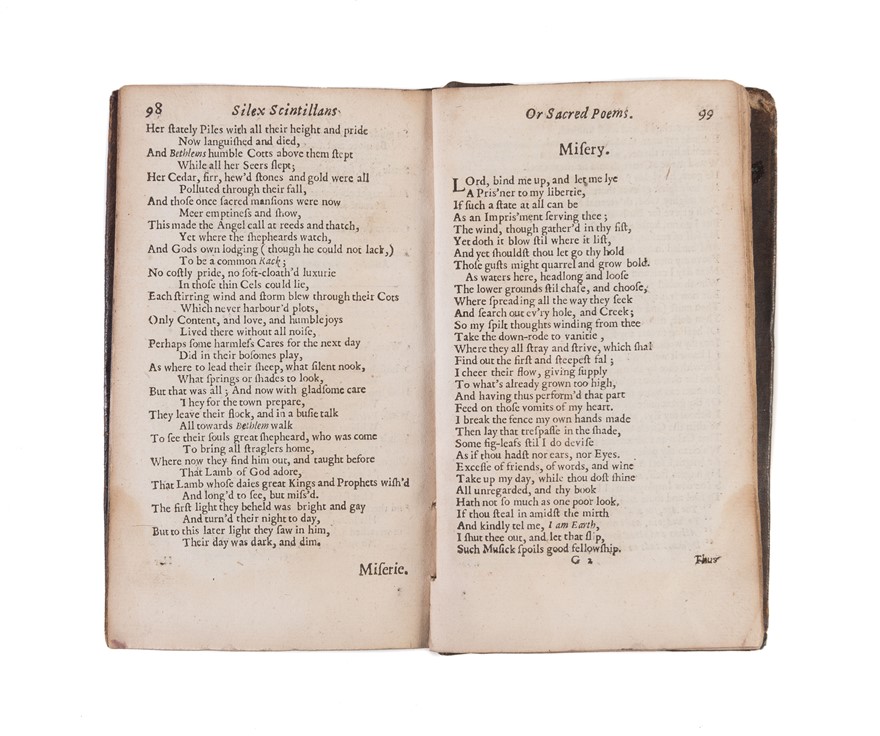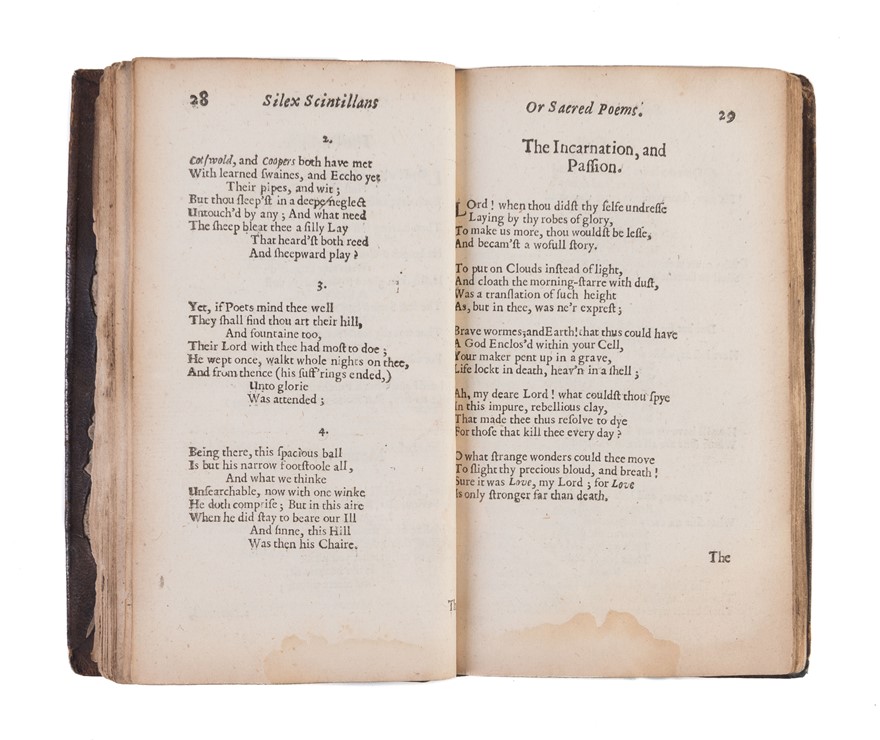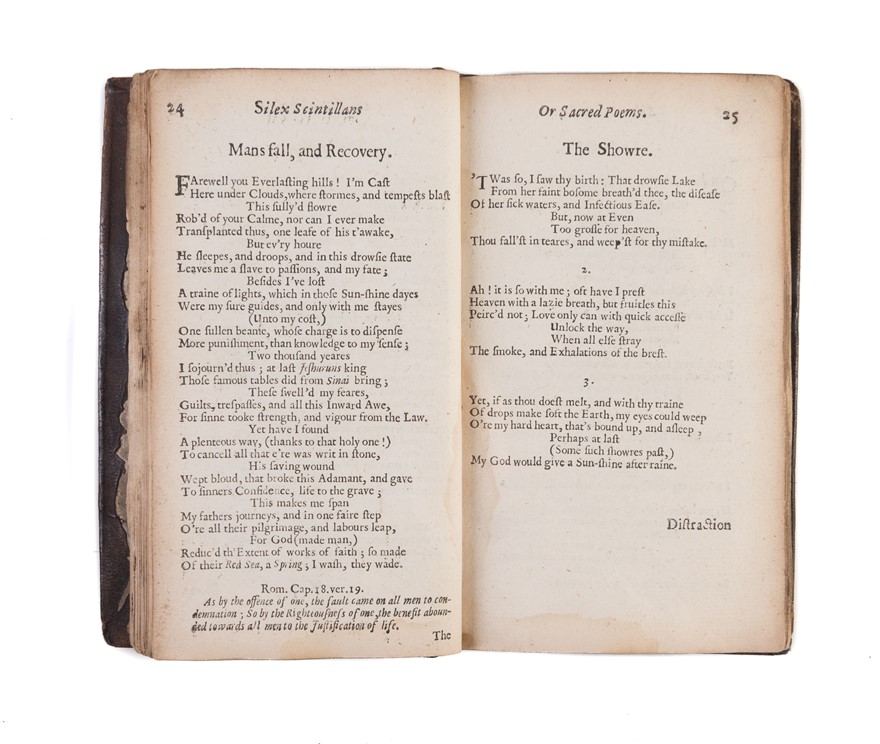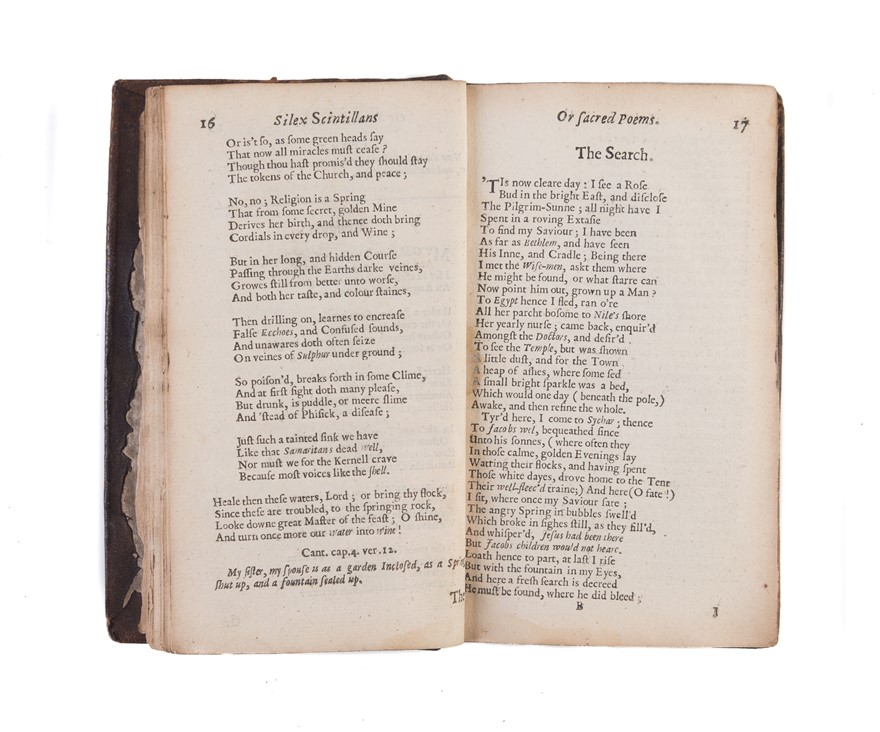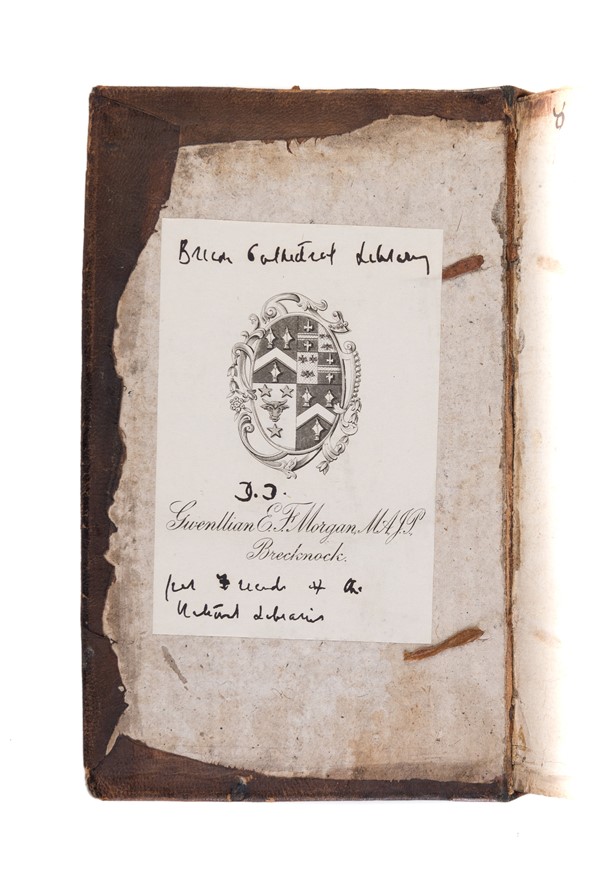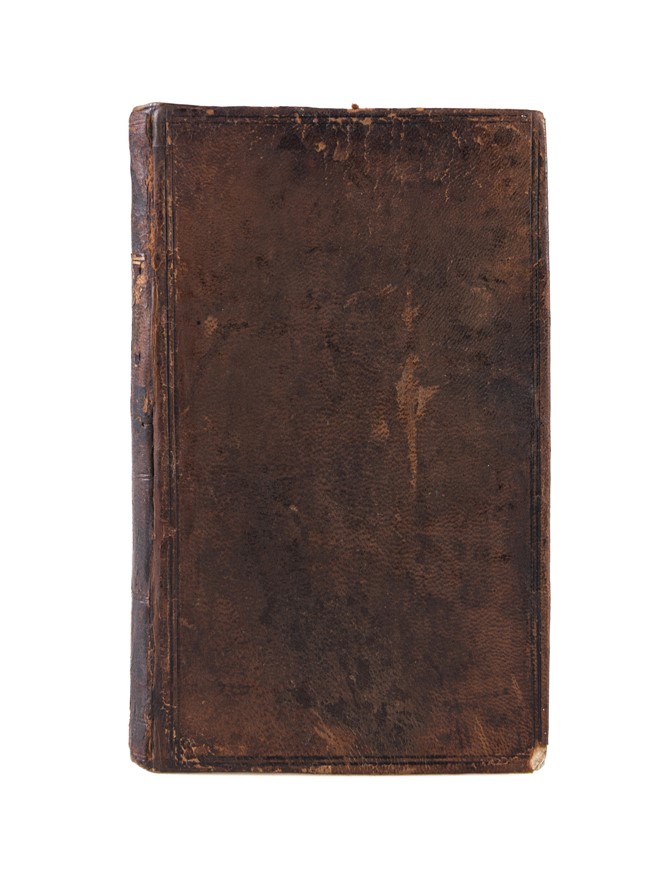Silex Scintillans: or Sacred Poems and Priuate Eiaculations By Henry Vaughan Silurist.
VAUGHAN Henry (1650)
£75000.00 [First Edition]
London: by T[homas]: W[alkley?]: for H[umphrey]: Blunden, 1650
First Edition. Small 8vo. [157 x 93mm]. [1-7 (inc. engraved title)], 9-110 pp., with the final blank leaf. Emblematic engraved titlepage (a heart of flint struck by a thunderbolt from Heaven), with leaf of explanation in Latin verse opposite. Sidenote on B3r very slightly shaved (heavily cropped in most copies), text lightly browned, minor damp-stain to the inner margin of the first couple of leaves and later affecting the lower margins in a few places and extending further up the page from top to bottom towards the end.
Contemporary plain sheepskin, covers with a double blind-ruled border, spine ruled in gilt, slight remains of an early red morocco label reading vertically “[SAC]RED | [POEMS]”, pastedowns unstuck (upper joint repaired, headcaps renewed; lower joint, lower corners and edges slightly rubbed). In a maroon pull-off case by Riviere.
Wing V125. A. F. Allison, Four Metaphysical Poets (Vaughan 8). Hayward, English Poetry, 81. Rare. ESTC records copies at British Library, Brecon Cathedral [this copy], Bodley, Worcester College Oxford (lacks G3-6; original sheep), National Library of Wales (William Cowper’s copy); Harvard (in green morocco by the Club Bindery, ex Hoe – Hagen – Jones - Chew), Illinois (first two leaves in facsimile), New York Public Library [false report], Princeton (Robert H. Taylor collection), Williams College, Yale (Tinker copy, without final blank, sidenote heavily cropped).
The very rare first edition of Vaughan's important collection of poems.
“Here in hymns and songs and longer lyric verse, Vaughan represents moments in a realization of himself. Part by part, one straining often to reject another, some only loosely bound in place – yet in their place – an individual emerges from obscure fragments of his past through pathways of a search for love, knowledge, and peace. At the end the man stands whole and comprehended.” - Thomas O. Calhoun, Henry Vaughan: The Achievement of ‘Silex Scintillans,’ 1981, p. 18.
This copy is larger than the Terry (‘the finest copy in existence’) - Houghton – The Garden - Pirie copy (Sotheby, New York, 3/12/2015, lot 813, $80,000 + premium, original sheep, spine repaired, ‘sidenotes cropped on one leaf’) reported as 150 x 90mm) but, even so, the sidenote of B3r has been slightly shaved. The Maggs marked copy of the Bradley Martin sale catalogue (Sotheby, New York, 1/5/1990, lot 3291 (contemporary sheep, upper cover detached, ex Yates – Bright – Pershing – Greenhill), $45,000 + premium) notes that it was “rather badly” wormed. No other copies are recorded as sold on ABPC or Rare Book Hub since 1950 (Huth – Harmsworth copy; rebound, sidenote and a few catchwords cropped). A poor copy, lacking the leaf of verses opposite the title and with damage to the engraved title was twice offered at Christie’s in 2017 but was unsold.
“Vaughan’s finest poetry was published in this rare volume. Its sales, however, were not large and unsold copies were re-issued with a second part in 1655.” (John Hayward).
The 1655 reissue (with a cancel title, “The second edition”, sold by Henry Crips and Lodowick Lloyd) is as rare. It has an extra 84-page section of new poems, the engraved title is replaced with a letterpress one, there is an added 11-page preface, “The Authors Preface to the following Hymns,” in which he bemoans the secular verse of idle wits (including his own early suppressed attempts) dated from “Newton by Usk, near Sketh-rock, Septem. 1654.” and a verse dedication to Jesus Christ. Leaves B2-3 are cancelled and replaced with a revised version of ‘Isaacs Marriage’ altering two lines on B2v and three on B3r which, referring to prayer as “very strange stuffe wherewith to court thy lasse” and “a Virgins native blush” must have been regretted by the author, and at the end is a 4-page ‘Table’ to both parts.
Silex Scintillans [The Sparking Flint] is the second and greatest collection of verse by Henry Vaughan (1621-95), known as ‘The Swan of Usk,’ (‘Olor Iscanus’) or ‘The Silurist’ as he termed himself after the River Usk or the Silures, the ancient tribe of his native south-east Wales. It was preceded by Poems, with the Tenth Satire of Juvenal Englished (1646) and followed by Olor Iscanus (1651; reissued in 1679).
The work of the Metaphysical Poets, as they were later termed, did not concur with later 17th and 18th Century poetical tastes - “for they cannot be said to have imitated anything; they neither copied nature nor life; neither painted the forms of matter, nor represented the operation of the intellect” (Samuel Johnson, Life of Abraham Cowley) - and they were little, if at all, reprinted until the 19th Century when, led by the Romantics, they were reappraised. None, though, suffered greater obscurity than Henry Vaughan, whose three collections of poems were not reprinted, even in his lifetime, until in 1847 the hymnwriter (‘Abide with me’) The Rev. Henry Francis Lyte produced an edition of Silex Scintillans prefixed by a life of Vaughan which concluded:
“That he will ever become a thoroughly popular poet is scarcely to be expected in this age. But among those who can prize poetic thought, even when clad in a dress somewhat quaint and antiquated, who love to commune with a heart overflowing with religious ardour, and who do not value this the les, because it has been lighted at the earlier and purer fires of Christianity, and has caught a portion of their youthful glow, poems like these of Henry Vaughan will not want their readers, no will such readers be unthankful to have our Author and his Works introduced to their acquaintance.”
Subsequently, Alexander B. Gosart edited Vaughan’s Works (4 vols. 1871) and Silex Scintillans was occasionally reprinted (Lyte’s edition was reprinted at Boston in 1856 and London in 1858 and 1883) and some his better-known poems began to appear in anthologies. A facsimile edition of the first issue of Silex Scintillans, with a preface by The Rev. William Clare, was published in 1885 (though it was from a copy without the leaf of verses opposite the title). In 1896 E. K. Chambers edited The Poems of Henry Vaughan in 2 vols.
Helen N. McMaster, in tracing the path of Vaughan’s revival in the 19th Century, dismissed the much-repeated idea that Vaughan had been discovered by William Wordsworth and that, in particular, his poem ‘The Retreate’ (p. 34 in Silex Scintillans) had influenced his ‘Ode. Intimations of Immortality.’ (“Vaughan and Wordsworth,” in The Review of English Studies, Vol. 11/43, July 1935, p. 313-25). More recently, however, Deanne Westbrook has discussed the close parallels between Vaughan’s poem ‘Regeneration’ (the opening poem in Silex Scintillans) and Wordsworth’s ‘Nutting’ and their mutual source in The Song of Songs (“Wordsworth’s Song of Songs: ‘Nutting’ as Mystical Allegory,” in The Wordsworth Circle, Vol. 30/1, Winter 1999, p. 36-47).
Henry Vaughan’s name is not so well-known as his Metaphysical contemporaries George Herbert, Abraham Cowley, and Andrew Marvell, and especially, from a generation earlier John Donne, though it out-shines that of Richard Crashaw who still languishes in the doldrums of unpopularity. However, not only has there been modern scholarly work on Vaughan’s poetry (e.g., Thomas O. Calhoun, Henry Vaughan: The Achievement of ‘Silex Scintillans,’ 1981, and Philip West, Henry Vaughan’s Silex Scintillans: Scripture Uses, 2001) but most recently, Donald R. Dickson, Alan Rudrum, and Robert Wilcher have edited The Works of Henry Vaughan (3 vols., Oxford University Press, 2018).
Today, Henry Vaughan is the subject of a wider popular reassessment as a poet of nature, as Alan Rudrum concludes in his ODNB entry:
“His finest lyrics challenge the best in their age; his achievements in rhythm have no peer until Hopkins; and if others had a better understanding of political process, none of his contemporaries understood better than he the relatedness of all living things and their relationship to what we call the inanimate world. He understood the New Testament's most important passage on the theology of nature, Romans 8: 19–22, as modern theologians do. What the science of his time could not prove, the intuition of the poet could express. Jurgen Moltmann understood well when he prefaced his God in Creation with Vaughan's poem 'The Book', which asserts the unity of creation and the value of all creatures. Victorian criticism of the metaphysicals may often seem dated, but it was astute of H. C. Beeching, introducing E. K. Chambers's edition of Vaughan's poems in 1896, to sense the force of an observation first made of Wordsworth and say that Vaughan too 'makes us feel that Nature is not a mere collection of phenomena, but infuses into her least approach some sense of her mysterious whole'. At the beginning of the twenty-first century some students of ‘environmental literature’ consider it anachronistic to think of ‘ecological consciousness’ as anything but a post-Darwinian phenomenon. Closer study of Vaughan, as of Milton, his greatest contemporary on the other side of the political divide, might convince them otherwise.” (ODNB).
As an example of this continuing reassessment, the artist Cy Twombly was inspired by Vaughan’s verses for his 1981 triptych, Silex Scintillans, which sold for $8.3 million in 2017.
Provenance: 1: No early marks of ownership except an old ink shelfmark “M 5” and a later pencil number “9547” on the rear flyleaf. 2: Anonymous sale, Hodgson's, 8/5/1924, lot 499 ["c[al]f., cracked"], £48 to: 3: Bernard Quaritch, with collation note at the end. 3: Gwenllian Elizabeth Fanny Morgan (1852-1939), M.A., J.P., of Brecknock, Wales, Mayor of Brecon (1910-11), and the first female mayor in Wales, with her armorial bookplate. With Louise Imogen Guiney (1861-1920), an American poet, critic and essayist who had moved to England, Gwenllian Morgan worked for many years towards an edition and biography of Vaughan; their notes were used by Francis E. Hutchinson in his biography, Henry Vaughan: A Life and Interpretation (Oxford, 1947); given in 1932 by Gwenllian Morgan through the Friends of the National Libraries to: 4: Brecon Cathedral, with ink note added to the Morgan bookplate; sold as surplus to requirement in 2005 through Maggs. 5: Private collection, USA.
Stock Code: 231998
